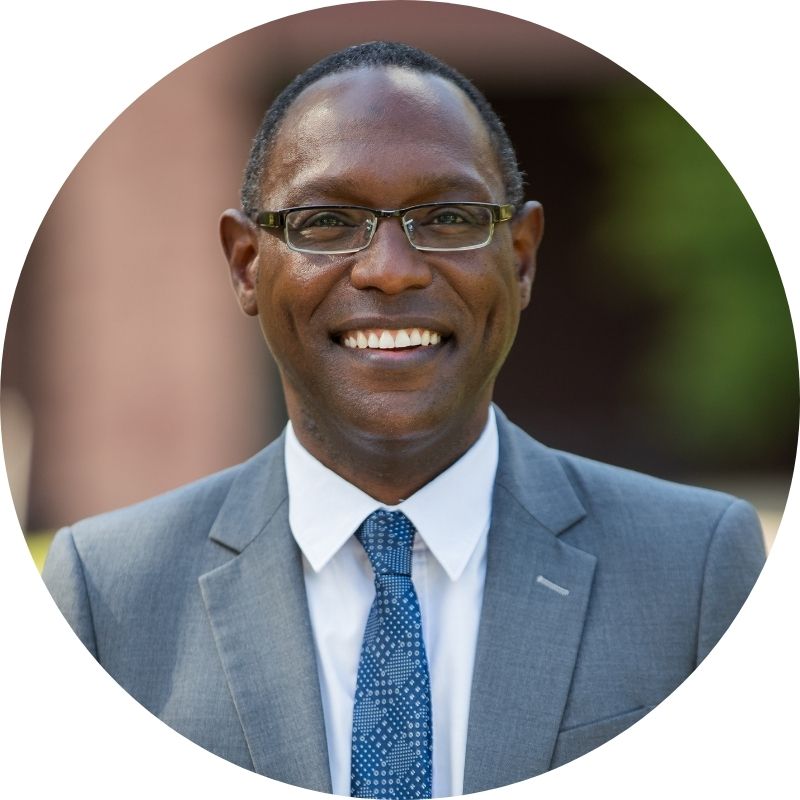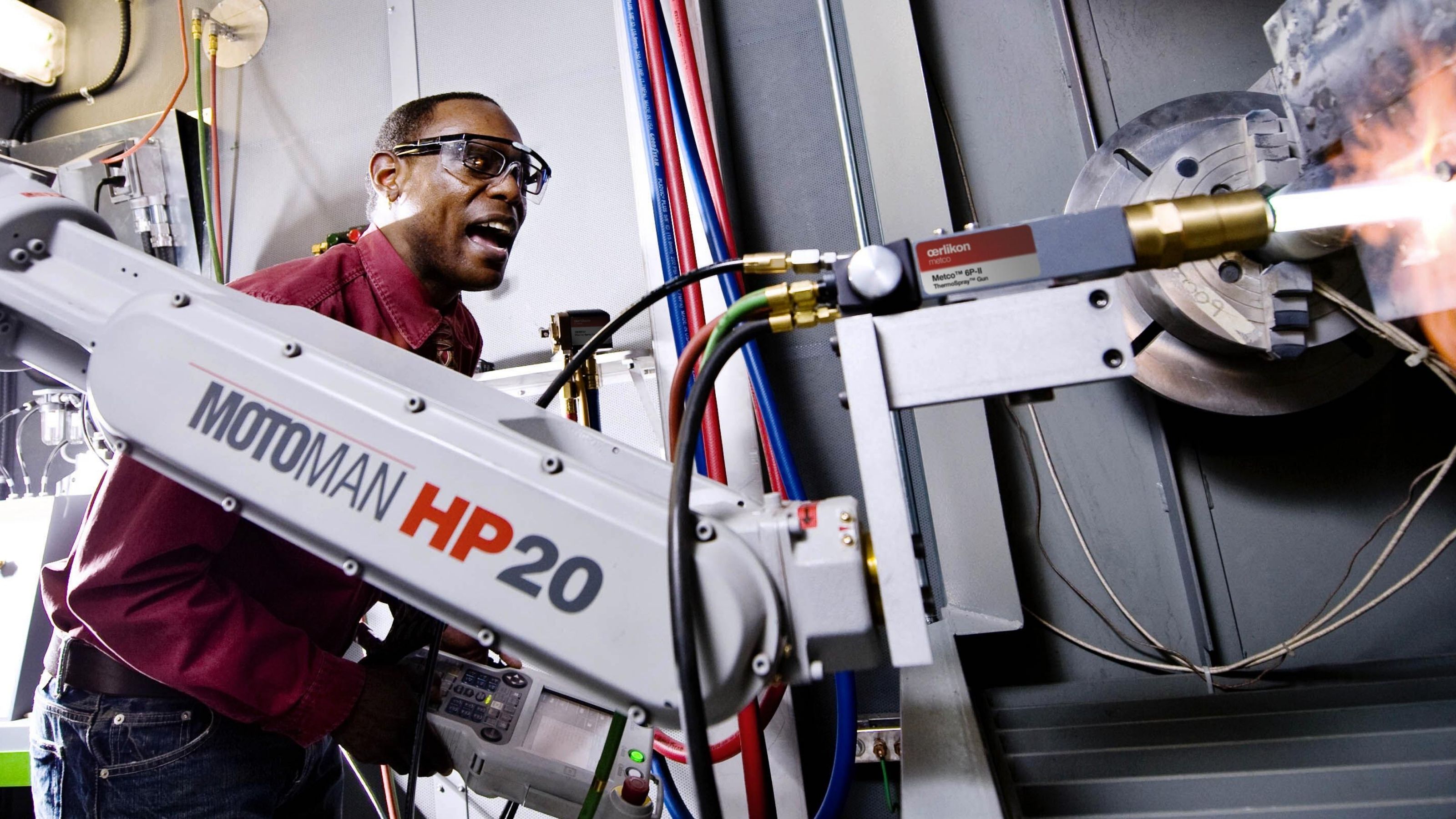A professor in the Department of Mechanical Engineering in the Faculty of Engineering, André McDonald’s extensive research and experience in creating and analyzing thermal- and cold-sprayed coatings for use in anti-icing and de-icing protocols on wind turbine blades and on aircraft wings can contribute to boosting equipment operations while helping to effectively reduce greenhouse gas emissions.
In this week’s spotlight, André shares how the novelty of his research addresses environmental and safety issues in the industry and of his personal commitment to help propel more Black youth to STEM fields and entrepreneurship.
How do you describe your work to people who don’t work in your field?
My research uses a high-temperature industrial process known as thermal spraying to fabricate next-generation coatings that protect machines and equipment from environmental damage. The novelty of my work is drawn from developing coatings that are multi-functional, in that they provide surface protection while performing other tasks such as heating to avoid freezing of water, acting as sensors to identify damage in a structure, or actively destroying bacteria and viruses.
What’s one big problem you want to solve through your work?
Ice accumulation on wind turbine blades and on aircraft wings poses serious safety issues, undermines operation of the turbines and aircrafts, and minimizes efforts at effective reduction of greenhouse gas emissions. I have been working to develop high-performance, low-cost, high-efficiency, and thin coatings that serve as heating elements for these machines. These coatings are being developed for use in anti-icing and de-icing protocols.
What does the word “innovation” mean to you?
For me, "innovation" means the creation of novel solutions either from foundational first principles, or assembling existing ideas from multiple disciplines to create unique solutions to existing problems. I personally enjoy assembling ideas to create new solutions and develop fresh ideas because it fully supports collaboration and diversity of thought in my research field.
What’s been your biggest a-ha moment — in life or work — so far?
My epiphany moment occurred about two years ago when I made a personal commitment to actively develop research, skills development, and full-time internship opportunities in STEM and business for Black youth in our community. This has materialized into the Experiential Learning in Innovation, Technology, and Entrepreneurship (ELITE) Program for Black Youth - an externally funded university-government-industry-community collaboration to support hands-on learning and work-integrated training of Black youth in STEM fields and in entrepreneurship.
How do you or your team come up with your best ideas?
We develop our best ideas when we talk to each other, especially informally. Although we are usually very busy, we make a point to spend time with each other to build or hone our relationships. It is during these times that our best ideas are ignited.
What’s your favourite thing about working at the U of A?
I enjoy the cognitive flexibility and agility that I have in the working environment at the U of A. This flexibility has allowed me to write numerous books drawn from research in coatings and from my own engineering practice to develop a textbook on the practical design of thermo-fluids systems. I have had the opportunity for agility to learn as I mature and grow in my profession here, having pursued a Law degree and integrating much of what I have learned in business and management consulting into strategic planning for research and technology development.
Do you have a role model at the U of A? How have they influenced you?
One of my role models has left the U of A, but made significant contributions to the institution and to me personally. That individual is Professor Larry Kostiuk. He was one of the former Chairs of the Department of Mechanical Engineering and a former Associate Vice President (Research and Innovation). Within our organization, he has a "giver" personality type, and his actions have built community and a sense of family in our Faculty and unit. I have applied an innumerable amount of his teachings and principles with great success to my research, teaching, and service work at the University and externally.
What’s next for you? Do you have any new projects on the horizon?
I am very excited about the ELITE Program for Black Youth. We have only been serving our community now for about 12 months, but we have made tremendous headway and are beginning to realize the impact of our work on the 15- to 22- year-old Black Youth interns in the Program. So, I will continue to work with my colleagues and external partners on our expansion and sustainability plans. In research, I have initiated plans to expand collaborations with other experts to develop ultra-high-strength coatings and expand on a predictive model behaviour of those coating materials. Our team is already internationally recognized for our modelling work in heat transfer performance of coatings. I think that our collaborative work on damage predictive modelling will only help to strengthen that international recognition.
This conversation has been edited for brevity and clarity.
Innovator Spotlight is a series that introduces you to a faculty or staff member whose big ideas are making a big difference.
Do you know someone who’s breaking boundaries at the U of A? (Maybe it’s you!) We’re interested in hearing from people who are creating new solutions to make our world better. We want to feature people working across all disciplines, whether they’re championing bold ways of thinking, driving discovery or translating insights from the lab into the market.
Get in touch at blog@ualberta.ca.

About ANDRÉ
Dr. André McDonald is currently a professor and the Immediate Past Associate Chair (Research) in the Department of Mechanical Engineering at the University of Alberta. Dr. McDonald has nearly twenty years of experience in the fabrication, development, and performance assessment of thermal- and cold-sprayed coatings. He also leads the ELITE Program for Black Youth – an externally funded university-government-industry-community collaboration to support hands-on learning and work-integrated training of Black Youth in STEM fields and in entrepreneurship.
